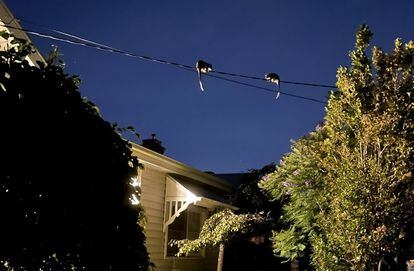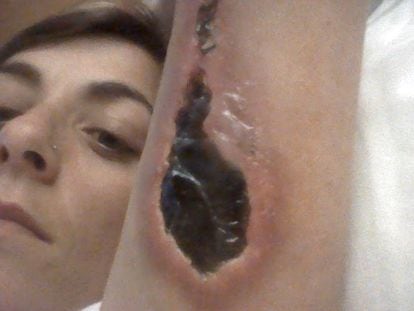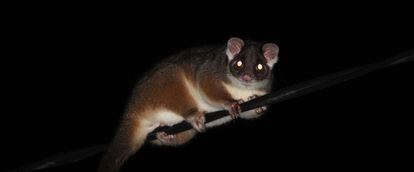The biologist Patricia Casas was the first spanish person who suffered one of the most forgotten diseases on the planet: Buruli ulcer, caused by a bacteria that devours human flesh and can disfigure the face and limbs. Casas spent five months in the jungles of Peru, for a conservation project stump monkey, and upon his return, a decade ago, something similar to a cigarette burn appeared on his left arm. Day after day, that sore continued to grow unstoppably, until it became a terrifying 12-centimeter ulcer, with an inflammation that connected his elbow to his armpit. Her doctors, overwhelmed by an unknown enemy, had to admit her to the León Hospital for a month and a half. “We didn't know what it was for so long that I called her Débora,” she remembers. Deborah devoured her arm and remained there for four years.
Buruli ulcer is one of the 20 neglected tropical diseases, a group of pathologies that are devastating in the poorest regions of the world, where the roads end. The 2,000 annual notifications of the bacteria are concentrated in central Africa, but cases have also been detected in other countries, such as Peru, Mexico and, above all, Australia. The great enigma is how the devouring microbe reaches humans and where it hides in nature. A team of Australian scientists now points to the alleged culprit: the mosquitos.
Casas, born in León 42 years ago, lived through hell. The bacteria, Mycobacterium ulcerans, is difficult to grow in the laboratory from the wound, so identifying it and getting the diagnosis right is very complex. The biologist went to an outpatient clinic in León on March 10, 2014, three months after returning from Peru. The health workers thought she had a simple burn and gave her ointment. As the sore continued to grow, they suspected an allergic reaction. Given the failure of the treatments, Casas ended up going to the Emergency Room of the León Hospital, scared. Doctors floundered for months while the germ consumed her arm. Until the diagnosis came: Buruli ulcer. The biologist had never heard of that disease.
The bacteria changed his life. Casas spent almost two years on antibiotics. The shock treatment damaged his liver and caused deafness. When his defenses were lowered, Débora reappeared and continued devouring his arm. After four years with as many surgeries, he was finally discharged permanently. Along the way, Casas had to abandon his passion, biology, and dedicate himself to hospitality. He now runs a hostel with a musical tavern in Pedrún de Torío, a town in León with 80 inhabitants. A huge scar reminds her of his ordeal. “I had a bite like I had been bitten by a shark,” she explains.
The transmission mechanism of Buruli ulcer has been a mystery since the disease was described. in 1948. Casas is convinced that, in her case, it all started with a mosquito bite on her left arm, one day when she was in a cabin in the Peruvian Amazon. A new study, published in the specialized magazine Nature Microbiologysupports your intuition.
The Australian city region of Melbourne has been experiencing a surge of infections since 2017, with more than 200 cases every year. The microbiologist's team Tim Stinear has deployed the means of a rich country to solve the riddle of the Buruli ulcer, a puzzle that remains alive because nothing like it has ever been done in the impoverished regions of Africa. Researchers have analyzed more than 65,000 mosquitoes on the Mornington Peninsula, a tourist area of beaches and vineyards about an hour's drive from Melbourne. There is more than one case for every 2,000 inhabitants.
Stinear's analyzes reveal that people suffering from the ulcer and mosquitoes carrying the bacteria overlap in the same areas. There is also a third actor: the ring-tailed phalanx, a marsupial mammal weighing just one kilo, which eats its own feces to make the most of the nutrients in eucalyptus leaves. The microbe that causes Buruli ulcer is also found in these excrements. The mosquito apparently carries the bacteria from the marsupial to humans. The University of Melbourne, where Stinear works, has proclaimed it's a statement: “An 80-year-old mystery solved: mosquitoes spread the flesh-eating Buruli ulcer.”

The Australian
microbiologist, however, is cautious. He recalls that the largest study carried out in Africa, in an area of Benin hit by the disease, barely examined 4,300 mosquitoes, without finding any associated with the bacteria. “Given that the frequency of positive mosquitoes in Australia was 1%, the absence of evidence in the Benin study does not mean evidence of absence,” Stinear tells EL PAÍS. The microbiologist recalls that other researchers, in the Ivory Coast, have pointed out some water insects as a possible transmission vector cane rats as an animal reservoir. For Stinear, it is urgent to conduct in-depth research in the most affected African regions.
The mosquito in the spotlight is the Aedes notoscriptusan Australian species that was detected in 2014 in the American city of Los Angeles and since then has invaded California. Microbiologist Tim Stinear believes it is “theoretically possible” for cases of Buruli ulcer to appear in the United States, provided there is an adequate animal reservoir and also the bacteria is introduced. The Melbourne region boasts a Mediterranean climatelike California, so Stinear also sees “no reason to rule out” that insects could transmit Buruli ulcer in the future in other temperate countries, such as Spain.

The mosquitos They tend to spread parasites, such as malaria, and viruses, such as dengue and yellow fever, but not bacteria. The biologist's team Jordi Figuerolafrom the Doñana Biological Station (CSIC), has created the Guadalquivir Mosquito Observatory, to track possible disease vectors. For the moment, Figuerola is not worried about the mosquito Aedes notoscriptus and Buruli ulcer, but the Aedes aegyptianother exotic mosquito, which invaded Spain for three centuries and caused serious epidemics of dengue and yellow fever until it was eradicated in the mid-20th century.
He Aedes aegypti has already been detected punctually in the Canary Islands on several occasions in recent years, although the Ministry of Health considers the situation under control. Figuerola warns that the inexorable increase in merchandise traffic—especially plants and used tires—and in the number of travelers will inevitably facilitate the movement of insects and diseases. “In addition, with the rise in temperatures due to climate change, the distribution of mosquitoes will expand and the number of months they will be active will increase,” he warns.
Patricia Casas wonders what would have happened to her if she had not had powerful free public healthcare and a doctor at her disposal, José Manuel Guerra Laso, totally dedicated to his healing. “They probably would have had to amputate my arm,” he laments. Casas urges authorities to allocate more resources to prevent the suffering caused by neglected diseases in the poorest countries. “It is in his hands and it should also be in his conscience and in his heart,” he says.

The biologist's case is unique in Spain. The biochemist Israel Cruzhead of International Health at the Carlos III Health Institute, only has evidence of one other previous patient: a 27 year old woman from Equatorial Guinea who, after four years with a Buruli ulcer in his left leg, traveled to Barcelona in 2003 to try to cure it. The doctors at Hospital del Mar had to amputate her limb due to a very aggressive ulcer, aggravated by HIV.
If diagnosed early, standard Buruli ulcer treatment only requires eight weeks of two antibiotics: rifampicin and clarithromycin. Still, the costs of the disease They are catastrophic for many families. Israel Cruz participates in an international consortium, coordinated by the University of Zaragoza, which tries to reduce the treatment time to just four weeks, adding amoxicillin and clavulanic acid. During the clinical trial, in remote areas of Benin and Ivory Coast, Cruz has seen patients with their limbs completely devoured by Buruli ulcer.
The biochemist applauds the new Australian study. “They have used all their artillery to unravel how transmission occurs in Australia. In Africa, however, there have been no financial resources to support research of this caliber. The ideal would be for the same desire and the same means to be put into place in the African context,” he laments.
Patricia Casas took it with humor, but feared for her life. There came a time when her ulcer “looked like a French omelet” placed on her arm. “My mother told me: “How is the tortillina?”, she remembers. The biologist laughed, but she was going through an ordeal. “Medical studies usually describe it as a painless ulcer, but nothing painless. It hurt me a lot,” she explains. With his defenses low, Casas abandoned biology, partly for fear of getting sick in contact with wildlife. “When I started as a waitress, I imagined that customers had the heads of birds, turtles or monkeys, to make my job easier,” she recalls. Her intention now, a decade after a flesh-eating bacteria burst into her life, is to return to biology: “I need hair and feathers now.”
You can write to us at [email protected] or follow SUBJECT in Facebook, Twitter, instagram or subscribe here to our bulletin.
Subscribe to continue reading
Read without limits
_
#Spaniard #attacked #bacteria #devours #human #flesh #It39s #bite #shark

